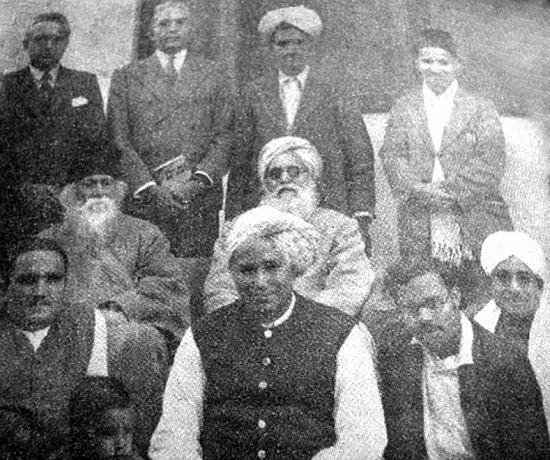Tagore echoes in the Punjab
Tagore wielded great influence on letters and arts in the Punjab. Many modelled themselves after this great figure of Bengal's renaissance, writes Nirupama Dutt

Tagore visited Lahore in 1934 and stayed with Lala Dhani Ram Bhalla, the proprietor of Bhalla Shoe Co. This picture was taken at his Nawaan Kot kothi mansion.
Photo by Niranjan Singh Nakodari
Amarjit Chandan Collection
Bengal and Punjab, so far away, are yet so near in many a significant moment in history. One could play on a limerick and say that the sons of Punjab are very good fighters, whilst the sons of Bengal are mostly writers. Major socio-political movements that started in Bengal, found their echoes in Punjab, be it the national struggle for Independence from the British regime, or the Naxalite movement of the late 1960s.
Manglesh Dabral, the Hindi poet, in a mood of spirited reflection, says: "The entire romance is either in Bengal or in Punjab. The rest of the country is dry and arid." His reference is, of course, to romance of the revolutionary variety.
The towering literary figure that ran parallel to the national struggle for freedom was undoubtedly that of Nobel Laureate Rabindranath Tagore. He was revered and knighted by the British imperialists. But the Jallianwala Bagh massacre on April 13, 1919, proved to be a turning point in his life. On May 30, 1919, he returned his knighthood in the poignantly penned letter to Viceroy Lord Chelmsford. The sentiments expressed in the letter went straight to the hearts of all self-respecting Indians, and the Punjabis at once accepted him as their very own. Tagore wrote in the historical letter: "The time has come when badges of honour make our shame glaring in the incongruous context of humiliation, and I, for my part, wish to stand, shorn, of all special distinctions, by the side of those of my countrymen who, for their so-called insignificance, are liable to suffer degradation not fit for human beings."
Punjab's history and the philosophy of the Sikh religion inspired Tagore to write three poems on Guru Gobind Singh and a poetic tribute to Banda Bahadar. He also wrote an essay on Guru Nanak's Sacha Sauda as a young adult in a Bengali magazine for children called Bãlak. Tagore also said that Gurbani had inspired some of the songs and compositions of Rabindra Sangeet. In fact, he also translated into Hindi Guru Nanak's Gagan Mein Thãl.
Several writers and painters in Punjab were influenced by the multi-dimensional talent of Gurudev Rabindranath, who was a poet, playwright, novelist, painter and musician. Many chose to dress like him, and among them were Punjabi writer Devendra Satyarthi and painter Sobha Singh.


Tagore at Lala Dhani Ram Bhalla's place in Lahore. 1934.
From left, first row standing: Balraj Bhalla, Yodh Raj Bhalla (who later became the Managing Director of Punjab National Bank) and two unidentified persons.
Seated: Tagore and Mahatma Hans Raj Bhalla.
Front row from right: Mahasha Khushal Chand, Ranbir Singh, Lala Dhani Ram Bhalla and Harikishan Bhalla. The boy sitting is unidentified too.
Picture source http://ranbir.vibhu.net
Ramesh Sharma, a Doordarshan executive, who had a close association with the latter, says: "Sobha Singh used to say that he was inspired to take to painting by seeing the works of Tagore. He dressed up like his ideal and used to say that as far as art goes, I am the Tagore of Punjab."
Also adorning the Tagore garb was the late Satyarthi, who first met Gurudev through acclaimed painter Nandlal Bose. He had a long relationship with him, visiting Santiniketan many times. In fact, he was inspired by both Gandhi and Tagore in executing the mammoth task of collecting the folk songs of Punjab as well as from some other parts of India by moving from village to village.
Satyarthi began this task in 1927, and he used to quote Tagore, who said: "The vitality of the Indian villager is India's real vitality. Villages are like women — in their keeping is the cradle of the race."
Satyarthi was deeply impressed by two poems of Gurudev, Katha Kaho and Urvashi. In fact, he asked Tagore if he could combine the two names for the title of one of his books. The permission was fondly given and Satyarthi's book was called Katha Kaho Urvashi. This title became very popular and was later borrowed by Dalip Kaur Tiwana for one of her novels. Tagore also gave names to the two older daughters of Satyarthi — Kavita and Alka.
Celebrated doyen of Punjabi letters, Gurbakhsh Singh, editor Preetlari, in 1938 set up the hamlet of Preet Nagar in the rural terrain of Punjab, equidistant from Lahore and Amritsar, inspired by the model of Vishvabharati at Santiniketan.
A close associate, Guru Dayal Malik of Santiniketan, was specially deputed by Tagore to visit Preet Nagar on June 30, 1941. He wrote in the Visitors' Book: "I am on pilgrimage to Preet Nagar, believing as I do that it is a miniature map of India in the making. It is the ideal of community building on the basis of mutual service and sacrifice. To me, Preet Nagar is the sister of Santiniketan."
Punjabi poet Amarjit Chandan recalls that it was Tagore who inspired both Balraj Sahni and Balwant Gargi to write in their mother tongue.
[Courtesy: Sunday Tribune. 8 May 201